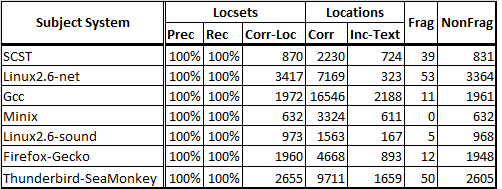Empirical Evaluation
Accuracy and Efficiency Evaluation in Renaming
We selected the Makefiles in 7 subject systems from their open-source
repositories as shown in TableI.

Table I: Subject Systems and Build Code Information
We asked six Ph.D. students to independently identify the locsets for consistent
renaming. We built a tool to assist them in that oracle building task. For each
string s, it performs text-searching for all occurrences of s
in a Makefile and included one(s). Human subjects examine those occurrences and
mark those which are variables’ names and require consistent renaming as
belonging to locsets.
The entire process took more than 40 hours. In Table I, columns
Locsets and Loc. display the number of
locsets and the total number of locations in locsets. A locset
can have multiple variables.
Complexity of Makefiles is expressed via the numbers of program elements.
LOCs(Line of Codes of Makefiles), Files (Makefiles), Vars (Variables), Rules
(Number of Rules), Paths (Number of branches with the Makefile), Includes
(Number of included Makefiles), Define (#variables defined using define)
, Foreach (# foreach statements), Eval (#eval statements), Call (#call
statements), |SDG| (The total number of nodes in the corresponding SDGs), Time
(time needed to build SDGs), and Mem (for the size of memory in MB for those
SDGs).
In Table II, Precision (column Prec) is the ratio of the correctly detected
locsets over the total detected ones. Recall (column Rec) is the ratio of the
correctly detected ones over the total number of locsets in the oracle. Column
Inc-Text shows the number of incorrect locations from the text-search tool.
Columns Frag and NonFrag
show the numbers of locsets with fragmented and nonfragmented variables.

Table II: Locset Detection Accuracy Result
Usefulness in Smell Detection and Renaming
Experiment Setting:
We invited 8 Ph.D. students at Iowa State University with 4-8 years of
programming experience who were divided into 2 groups. We also provided a short
training session for all subjects. We applied the crossover technique. That is,
Group 1 performed tasks 1, 3, and 5 using SYMake and other tasks without SYMake.
The opposite is for Group 2.
To view the tasks assigned, please visit [Controlled
Experiement Tasks Section]
Controlled Experiment Results:
Tool’s usefulness is measured via code quality and developer’s effort. For
quality, in the detection tasks, we compared the numbers of smells
correctly/incorrectly detected and missed without using tool or using it (two
numbers are side-by-side, Table III). Precision and
recall for location detection is in
Prec-Loc and Recall-Loc. In the renaming
tasks, we calculated the precision (Prec) and recall (Rec)
of renaming locations. Developer effort is measured via finishing time. If the
time limit was passed, (s)he was required to stop.

Table III: Controlled Experiment's Result
- For a detailed result for each of the subject, you can download their
individual results. [All-Results.zip 95KB]
- For a detailed aggregated results from all subjects, you can download those
results. [ControlledExperiment-Results.xlsx
22KB]



